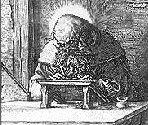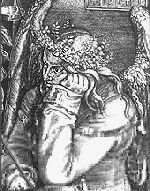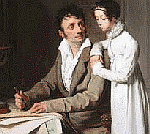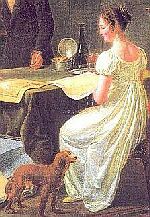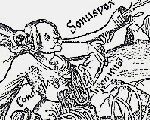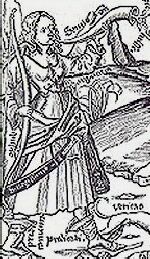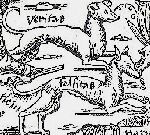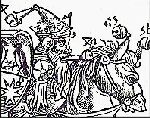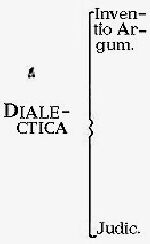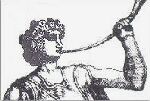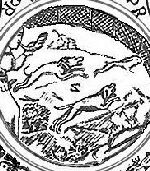Clever Dogs and Nimble Spaniels: |
|
In the verbal imagery and visual representation of some intellectual and artistic key concepts such as logic, dialectic, invention, and imagination, dogs play an important part. Why? In exploring this question my aim is not a study of the mind and behaviour of dogs but a modest contribution to intellectual history. Looking at canine metaphors and analogies used in the past for the art of logic and related concepts may lead to a better understanding of the meanings former generations attached to such concepts. Of the many metaphors used to conceptualise the arts of discourse in the Renaissance, the image of the dog may most aptly convey the properties of those natural human faculties - reason, imagination, and memory - that search out and "retrieve" ideas. Lacking a sophisticated medical or psychological model of human cognition, this age thus attempted to explain the operations of invention through natural rather than supernatural imagery. Dog-like, the mind ranges through its memories and associations to retrieve thought otherwise hidden. The first examples are two key texts from seventeenth-century England.
In March, 1615, when James I and his court visited the University of Cambridge, an academic disputation was held between John Preston of Queen's College and Matthew Wren of Pembroke College about the question of whether dogs could make a syllogism. The subject had been specially chosen to accord with the king's love of hunting.1 Preston affirmed the thesis; he argued that a hunting dog progresses logically from the propositio maior of several possible escape routes of the hare and the propositio minor, eliminating those that do not give a scent, to the conclusio that the remaining route must be the right one, which it then pursues. Wren, who was, by the way, the future bishop of Norwich and uncle of Sir Christopher Wren, objected that dogs were not logici, only nasuti, endowed with a fine nose. Here the moderator, Dr. Read, wanted to close the canine debate, but the king, a great debater, huntsman, and dog lover, intervened in favour of logical dogs. He gave several pertinent examples from his own observation and told the assembled academics that many dogs had more sense than some professors. Wren withdrew with an elegant compliment: as His Majesty's dogs hunted by royal prerogative and not by common law, they were no doubt able to perform a syllogism. This delightful story has often been told as an example of the custom of academic mock disputations. Richard Corbett, who had come over from Oxford for the event, wrote some humorous lines on it:
|
Philosophers did well their parts, Which prov'd them Maisters of their Arts; Their Moderator was no foole, Hee far from Cambridge kept a Schoole. But to conclude, the King was pleas'd, And of the Court the Town was easd. (111) |
However, the subject of the debate stands in a long tradition of serious argument and reflects the predominant opinion of classical and medieval authors about the sagacitas canis. Edward Topsell, the Jacobean writer on zoology, calls dogs subtle, swift, faithful, and "smelling" and goes on:
Ælianus thinkes that Dogges have reason, & vse logick in their hunting, for they will cast about for the game, as a disputant doth for the truth, as if they should say either the Hare is gone on the left hand, or on the right hand, or straight forward, but not on the left or right hand and therefore straight forward. Whereupon he runneth foorth right after the true and infallible footesteps of the Hare. (141)In his chapter "De canibus dialectica quodammodo utentibus," Claudius Ælianus, the Roman compiler of animal lore, reports the same details as Topsell about the arguta canis, the clever dog (De natura animalium 6.95). The Middle Ages, following Isidor of Seville, were convinced that dogs were cleverer and possessed better senses than any other animal: "Nihil autem sagacius canibus; plus enim sensus ceteris animalibus habent" ("There is nothing wiser than dogs; they have more senses than any other animal." [Isidore 12:2.25-26]). Some dogs, it was stated, had even appeared as witnesses in a court of law, and another dog had shrewdly increased the level of wine in a vessel by dropping in stones so that it could drink the wine. Similar stories are told about other clever animals. The most important early authority for these opinions on the abilities of the dog is a passage from St. Basil, the great fourth-century church father, in his Homilies on Genesis. He stresses the natural intelligence and intuition of the dog, and the sympathetic treatment of the animal by later ecclesiastical authors such as Ambrosius is mainly due to his influence. The relevant passage from Basil reads in free translation:2
The dog is not all that intelligent, and, yet, he has a sense which compensates for this shortcoming. Whereas the wise of our world may spend a lifetime of laborious meditation on the making of syllogisms, dogs manage to clear up such problems naturally. Pursuing his quarry and finding that the tracks part in different directions, the dog examines the tracks, and with little trouble he works out his syllogistic reasoning. The prey, he reasons, has escaped either hither or thither, or in a quite different direction, and since it is neither here or there, only one direction remains. Thus... the dog discloses the truth. So do also those grave men of thought, who, seated in front of geometrical figures, draw lines in the sand and, confronted with three propositions, have to discard two in order to discover the truth of the one that remains. (9.84 D)
We will now examine a second seventeenth-century English key text on the subject, a central statement of neoclassicist literary theory. In the Dedicatory Letter to Annus Mirabilis (1667), Dryden compares the faculties of wit or imagination to those of a nimble spaniel.3
The composition of all poems is, or ought to be, of wit; and wit in the poet, or Wit writing, (if you will give me leave to use a school-distinction), is no other than the faculty of imagination in the writer, which, like a nimble spaniel, beats over and ranges through the field of memory, till it springs the quarry it hunted after; or, without metaphor, which searches over all the memory for the species or ideas of those things which it designs to represent. (1.14)
No doubt Dryden knew Hobbes's similar remark in Leviathan (1651), that "the consequence or train of imaginations ... or TRAIN of thoughts" works "in the same manner as one would sweep a room, to find a jewel; or as a spaniel ranges the field, till he finds the scent" (ch. 3, 13-15). The metaphor of ranging over the field of the mind or memory in search of ideas or images was widely applied in the Renaissance (with or without the help of a metaphorical dog) to the process of reasoning and especially to the mental activities involved in literary composition, often called invention or imagination. Sidney observes that "true poets range, only rayned with learned discretion, unto the divine consideration of what may be, and should be" (1.159). He describes the poet's invention as "freely ranging onely within the Zodiack of his owne wit" (1.156).
So far, the ranging spaniel or its activities have been interpreted, in bonam partem, as an example of systematic searching and orderly composition. But in 1650 the Puritan-minded Thomas Goodwin compares the unruly and dissolute thoughts of fallen man to "wanton Spaniels, who doe runne after every Bird" (14). Even earlier, in 1621, Robert Burton had aptly characterised his own digressive mind and mode of composition in the ever-expanding Anatomy of Melancholy by comparing them to a "ranging Spaniel, that barkes at every bird he sees, leaving his game" (4). However, with Burton, human beings are not left at the mercy of their disorderly humoral or astrological disposition; counter-measures are available, resources of reason and judgment or what Sidney had called "learned discretion," also arts and techniques of logical anatomy to bring about order and method.
Looking back at the two key texts, one would think that there must be some common ground or link between the logical hunting dog of the Cambridge disputation and the nimble spaniel or retriever of Dryden and other critics. Before I make this connection I will trace briefly the pedigree of the metaphorical nimble retriever. It seems to originate with the Spanish doctor, Juan Huarte and his work of early psychology, Examen de Ingenios (An Examination of Men's Wit). This important book, first published in 1575, saw over eighty editions and numerous translations.
Critics have drawn attention to the link between Hobbes and Huarte, but they have failed to examine Huarte's seminal statement in the Spanish original and the shifts of meaning in successive translations. Huarte's book is the earliest quasi-scientific treatise on vocational counselling for various professions. It presents a theory of the faculties of the mind derived from Aristotle and Galenos. Taking the three faculties of the mind, reason (entendimiento), memory (memoria), and imagination (imaginativa) as indicators, he establishes the required mental disposition for the professions of orator and poet, cleric, lawyer, physician, general, and king. In spite of some abstruse pseudo-science - how parents may beget clever and academically-gifted children and may determine their gender (in chapters 3 and 15) - Huarte's impact on the history of aesthetics is considerable. Following Cardano, Telesio, and Campanella, he showed that imagination is basically not something fantastic, abnormal, or pathological but that it has its place in the hierarchy of normal mental functions and is a necessary requirement for orators, for poets, and for every artistic and creative activity.
According to Huarte, the perfect orator must possess a high or subtle4 imagination like a hunting dog that smells and searches out the game and brings it to hand: "muy subida imaginativa que sea como perro ventor que le busque y traiga la caza a la mano" (144). While Huarte's French translator Gabriel Chappuis remains relatively close to the Spanish original ("une grande imagination" [126], Camillo Camilli, the Italian, introduces a significant variation of meaning, the quickness of the imagination ("una imaginatiua molto ueloce" [144]) and is followed by Richard Carew, the first English translator ("a very swift imagination," [131]), Edward Bellamy ("a quick Imagination," [221]), and Gotthold Ephraim Lessing ("eine geschwinde Einbildungskraft," [218]). Carew's influential Elizabethan version of Huarte, which had four editions, deserves to be quoted in context:
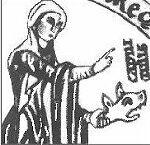
Fig. 2
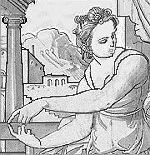
Fig. 3
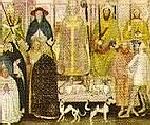
The second grace which may not be wanting in a perfect Orator, is to possesse much inuention, or much reading, for if he rest bound to dilate and confirme any matter... it behooueth that he haue a very swift imagination, and that the same supplie (as it were) the place of a braach, to hunt and bring the game to his hand. (Carew 131)
Through successive translations, the concept of swiftness or velocity became firmly attached to the imagination, reinforced, one assumes, by classical ideas of the winged and flying Pegasus, the poet's horse overcoming the limitations of time and space.5 Carew's word braach (from Camilli's Italian bracco, in modern English brach, a bitch hound), originally meant a hound hunting by scent. Later on, the name of a more popular breed, the spaniel, was substituted, but its essential quality, the smelling out, finding, and bringing back of the game, remained the same and made it the perfect animal to visualise the function of the imagination or invention, the finding of ideas or arguments, inventio argumentorum. I have shown elsewhere in more detail how during the Renaissance, for instance with Ronsard, Sidney, and Puttenham, and up to Dryden and Hobbes, inventio, rooted in classical logic and rhetoric, and imaginatio (or phantasia), deriving from ancient psychology, became amalgamated and virtually identical ("John Dryden's" 233-49). At the same time, the association of the imagination with dangerous fantasies or hallucinations was reduced, though not altogether eliminated. As the next quotation shows, Dryden's poetics still bas a strong rhetorical flavor:
So then the first happiness of the poet's imagination is properly invention, or finding of the thought; the second is fancy, or the variation, deriving, or moulding, of that thought, as the judgement represents it proper to the subject; the third is elocution. (Annus Mirabilis 1.15)
Invention and judgement (iudicium) are the first two parts of dialectic or logic and of rhetoric. In this historical context, imagination and invention involve the finding of what is already extant, and it is only in a Romantic or pre-Romantic sensibility that these terms assume notions of creating something valuable, new, and original. For Wordsworth, in the Preface of 1815 to the Lyrical Ballads, imagination becomes a creating, shaping, and unifying power, and Coleridge regards the primary imagination as a repetition in the finite mind of the eternal act of creation in the Infinite "I Am" (ch. 13).
It has been shown in this essay that the dog of the Cambridge disputation and Dryden's nimble spaniel were supposed to possess a canine version of the art of dialectic, one of the Seven Liberal Arts, defined as the art of reasoning or discoursing well. We will now look out for dogs in the iconography of the Liberal Arts. Especially under the reign of scholastic philosophy from the eleventh to the fourteenth century, dialectic held the place of honour in the Trivium over grammar and rhetoric. Martianus Capella, Alanus ab Insulis, and, later, Cesare Ripa served as the main literary sources for its personifications and attributes: serpents, scorpions, scales, fish hooks, daggers, keys, and the so-called formulae or tablets. Elsewhere one finds swallows (chattering birds) or frogs (garrulous creatures), but dogs are not often seen at this early stage.6
A miniature of the Liberal Arts from the Hortus deliciarum of Herrad of Landsberg (d. 1195), has at least part of a dog (Fig. 1). Lady Dialectica is dressed elegantly in courtly fashion, wearing a yellow hood and a green gown with enormous sleeves, her right hand pointing, her left hand holding a dog's head (caput canis) with bared teeth. The inscription reads:
"Argumenta sino concurrere more canino" ("I allow arguments to clash - or to follow each other - in canine manner"). The art historian Ludwig Heinrich Heydenreich speaks of a hundeköpfige Schlange (a serpent with a dog's head) in the lady's hand (1392) - bad eyesight or wishful thinking? He expected to find, if not the whole, at least part of the more usual serpent. In 1979 Karl-August Wirth corrected the mistake in a thorough study of the iconography of the Artes liberales (73). He argued that more canino, like growling and barking (latratus), could be interpreted in malam partem as loud, aggressive, rude, and sophistical but also in bonam partem as symbolising the zealous and vigilant orator and preacher fighting valiantly for the truth in the duellum logicae.
An interpretation aiming at the preacher is even more conspicuous in a unique and not very refined drawing of Loyca or Logica in a mid-fifteenth century Viennese manuscript, the object of Wirth's exhaustive study (68). Logica, with a human body and a dog's head, sits on a chair under a canopy. She is engaged in a disputation with a young man, a cleric. Both figures use typical hand gestures for the affirmation and negation of a conclusion, described as conclusiua tenet and nego conclusiuam in the captions.
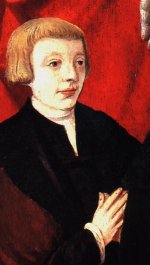
Fig. 5
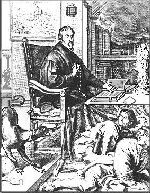
Interesting canine associations occur in the iconography of the famous Catholic reformer, the Jesuit Petrus Canisius (1521-97), beatified in 1864, canonised and declared a Doctor of the Church in 1925. As author of acclaimed catechisms and other theological works, founder of Jesuit colleges, educator, and preacher, he secured the patronage of die Archduke and later King and Emperor, Ferdinand I, and laboured tirelessly for the success of the Counter Reformation in Central Europe. The name of his Dutch family from Nijmegen was Kanis or Canis (with further spelling variants). In 1538, as a young schoolboy in Cologne, he inscribed his notebook with "Petrus Kannees Nouiomagus" (Petrus Kanis of Nijmegen) and the motto PERSEVERA (Begheyn; Haub). Despite occasional statements to the contrary, the name is not a Latinized form of German Hund or Dutch (de) Hond. However, on a family triptych his father Jacob Kanis put up a punning coat of arms exhibiting a greyhound in the upper field. In the lower part of the triptych young Peter Kanis stands behind his father (Fig. 4). Canisius himself, but also his adversaries, exploited the similarity of his name to the Latin word canis (dog) by frequent punning allusions. When he was active in Vienna, Protestant controversialists denounced him as Canis Austriacus or Hellischer Hundt (hell-hound). In his will he stated that he had wished not to be a mute dog but to speak out loudly from his orthodox cathedra.
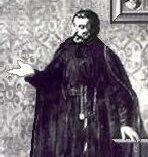
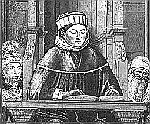
In Dürer's engraving of 1514, St. Jerome in his Study (Fig. 8), the artist has added a sleeping dog to the traditional lion. His composition follows the type of the humanist's portrait with a dog in his study, established earlier in portraits of Petrarch. Reuterswärd and J. W. Trapp discuss such portraits, and Trapp notes that Petrarch owned a dog and a cat as pets. St. Jerome's dog signifies both peaceful coexistence with the big lion under the influence of saintliness and also humanist fidelity to scholarly work as well as sagacity and perseverance, virtues befitting the scholar.
Dürer's engraving Melencolia I (Fig. 9), also executed in 1514, represents an exceedingly rich and complex synthesis of artistic and intellectual traditions (Klibansky, Panofsky, and Saxl). By placing the sleepy, curled-up dog at the feet of the brooding personification of Melancholy, Dürer again follows the general concept of the dog in the humanist's study. A dog can be a fitting companion to the melancholic scholar whose intellectual brilliancy and melancholic temperament are but two sides of the same Saturnine disposition. Specifically, Dürer's composition is indebted to the iconographical representation of Geometria as one of the Liberal Arts; it has indeed many similarities with the woodcut of Geometria in Reisch's Margarita philosophica. Dürer provides a place and the tools for a variety of creative geometrical, mathematical, artistic, literary, and technical work, from architecture to alchemy and white magic. But under the impact of melancholic acedia, work has almost ceased. The woman looks tired and listless, the putto scribbles ineffectively, the tools are in disarray, the rhombohedron is blunted, the building unfinished, the sea encroaching, the higher steps of the ladder invisible. The "imaginative melancholy" of Melencolia I is subject to the restrictions of space and sensory perception. Dürer may have anticipated higher forms of thought, vision, and contemplation in the categories of Agrippa von Nettesheim, namely Melencolia II (rationalis) and Melencolia III (mentalis).
The sleeping, lean, and hungry dog is part of the general picture of sluggish inactivity. But Dürer knew Horapollo and the hieroglyphical interpretation of the dog as a creature endowed with prophetic and intuitive abilities. Arguably, he may have wished to suggest that the dog, while physically inactive, was intuitively divining the arcane meaning of cosmic manifestations in the sky.
At the number 12, one of my hounds is lying at my feet. This dog was exceptionally faithful and sagacious and is shown in shape and size much as he was in life, a symbol not only of his noble race but also of his sagacity and fidelty [nontam nobilitatis, quam sagacitatis & fidelitatis hieroglyphicam]. (sig. B4v)9
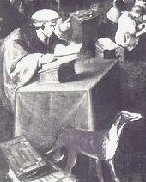
The iconographical type of the dog in the humanist's study lingers on into the nineteenth century. In a painting called The Geography Lesson (1812) by Louis-Léopold Boilly (Fig. 11), the teacher-pupil and the father-daughter relationship bas been beautifully worked out while a formidable array of geographical maps, books, and instruments leaves no doubt that in this study serious educational work is done. A little dog on the right, facing the viewer, completes the triangular composition. Telling details of this scene suggest a relationship between the figures in which authority and formality, as well as informality, trust, and intimacy, play their part. Obviously the dog emphasises the latter qualities. Only slight traces of the original symbolism survive in a later domestic modification of the type: The History Lesson (Der Geschichtsunterricht) by Georg Adam, before 1830, takes us into the drawing room of a cultured bourgeois German family10 A rather authoritarian father, assisted by his wife and another lady, instructs his young son with the help of historical prints, portraits of Nero and Metternich among them - a political allusion to the latter's restoration of peace and prosperity after the ravages of Napoleon's imperialist wars? A little dog seems unimpressed by the family's activities and is more indicative of domestic life than intellectual effort (Fig. 12). Throughout the iconographical tradition of clever dogs, it is not always possible to distinguish clearly between their symbolic function and their emotional appeal and role as household pets.
From the wide iconographical field of Christian ad humanist scholarship and its later transformations we return to representations of logic. Figure 13 reproduces the most attractive and influential document of the iconographical tradition of logical hunting dogs. It is a woodcut called "Typus Logice" (the "Picture of Logic") in Gregor Reisch's Margarita philosophica.11 Reisch's work, widely used as a textbook in schools and universities, was originally published by the printer Johannes Schott in Freiburg in 1503. Our photograph of the woodcut comes from Schott's Basel edition of 1517 and is very close to the one in the first edition. An edition of 1496 mentioned by some bibliographers is a ghost. The book is an encyc1opaedia of the Seven Liberal Arts with twelve woodcuts, perhaps by Michael Wolgemut of Nuremberg, the teacher of Dürer. Stephen Hawes's allegorical poem, The Pastime of Pleasure, was modelled on Reisch's Margarita but omits the relevant woodcut of Logica.
In "Typus Logice," Dame Logica is represented as a huntress chasing the hare Problema with her retriever dogs Veritas and Falsitas. The picture has often been misunderstood: the lady has been called an angel by Muther and a huntsman by Prantl (no male chauvinism, just bad eyesight), and Srbik misjudged the woodcut as a satire against academic logic.12 While some of the details of the illustration are difficult to see in this lively and impressive memory picture, the chief technical terms of Aristotelian and scholastic logic are allegorised for didactic purposes with the help of various aspects of hunting and hunting equipment. Dame Logica strides forcibly forward on her way, avoiding the Sylua opinionum (the "forest of opinions")13 as well as the covert of the Insolubilia ("insoluble problems"). The forest consists of trees named after famous scholastic philosophers: Albertiste, Scotiste, Occamiste, and Thomiste. There are some bushes by the wayside, Parua logicalia ("elementary logical matters"), and the stones Fallacie in dictione and Fallacie extra dictionem (that is, linguistic and extralinguistic fallacies) may prove troublesome. Veritas, the nimble retriever, has almost caught up with the hare, while Falsitas stands idly by, only interested in a tree-stump. The buxom huntress lustily blows her horn Sonus Vox ("spoken word"), from which two Premisse in the shape of two roses emerge. Dame Logica's dress and equipment include the stomacher Conclusiones, the bow Questio, the hunting-knife Syllogismus, he boots Predicamenta and Predicabilia, and the quiver Locus from which the arrows, Argumenta, will be drawn.14 These details of a quiver and arrows have not been identified or understood by modern critics. And yet, they demonstrate an important development in the history of logic, that is, the growth of topical or place logic. Topical logic was to become even more important in the humanistic systems of logic propounded by the Friesian, Rudolph Agricola, and the Frenchman, Petrus Ramus (Pierre de la Ramée).
A Place is the restyng corner of an argument, or els a marke whiche giueth warnyng to our memory what we maie speake probablie, either in one parte, or the other, upon all causes that fall in question. Those that be good hare finders will sone finde the hare by her fourme. For when they se the grounde beaten flatte round aboute, and faire to the sight: thei haue a narrow gesse by al likelihod that the hare was there a litle before. Likewyse the hontesman in huntyng the foxe, wil sone espie when he seeth a hole, whether it be a foxe borough, or not. So he that will take profite in this parte of logique, must be like a hunter, and learne by labour to knowe the boroughes. For these places be nothyng els but couertes or boroughes, wherein if any one serche diligentlie, he maie fynde game at pleasure... . Therfore if any one will do good in this kynde, he must go from place to place, and by serching euery borough, he shall haue his purpose undoubtedlie in moste part of them if not in all. (sig. J5v-J6r)
As Walter Ong, the doyen of Ramist studies, remarks, it is "a fascinating passage... a marvelous dialectical hunting scene" (119). The places, by the way, may be inartificial (witnesses or documents) or artificial (belonging to the art of logic), for instance definitio, divisio, genus, species, similitudo, differentia, contrarium, causa, effectus, etc. Especially under the later influence of Ramism, progression through these places, perhaps from definitio to causa finalis absolutae, became an accepted method of orderly composition. Ramist method applied by poets might produce brilliant and witty argumentation and persuasion (for instance in the conceits of the Metaphysical Poets), or boring, predictable and pedantic amplification. The importance of the places becomes clear from a detail in the bottom left corner of the woodcut. The squatting figure of a man is the legendary Parmenides Egipticus who, according to John of Salisbury and Hugo of St. Victor, spent his life on a rock (in rupe) to discover the logical loci, only to have them taken away from him by his disciples because his discovery had made him so famous. The iconography of "Typus Logice" is derived from realistic hunting scenes but also from spiritual applications such as the "Mystical Hunt" attributed to Martin Schongauer. It is an allegory of the Annunciation set in a Hortus conclusus and it gives to the Angel the familiar attributes of the huntress (Fig. 14). The altar painting from a former Dominican church is now in the Museum Unterlinden in Colmar, France.
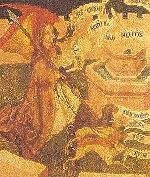
Ong calls Murner's simplified method "emblem-book logic" (91), which sets out to popularise the art of logic derived from the influential Summulae logicales of the scholastic, Petrus Hispanus, by turning it into a story to be told in pictures. Admittedly, the general arrangement of words and pictures on the printed page is similar to that of an emblem book. But whereas each emblem ideally constructs a new and ingenious meaning out of its three parts, Murner's allegorical playing-cards function only as space for fixing disparate mnemotechnical symbols keyed by letters and numbers to an appended list of signs, terms, and rules (sig. Aiiijv). Here, in the list of signs, a bell stands for "enunciatio." The allegorical woodcut of the King of Bells before the First Application of the First Tract (sig. Bii) helps to explain two kinds of the vox significativa, of articulation or enunciation (Fig. 17). Depicted on the hind parts of the horse and its caparisons is a dog's head numbered a6 (or 6a) with a protruding tongue and a bell attached to it. Number 6b shows a human head with a protruding tongue and a bell. Number 6a signifies the natural voice or enunciation of a dog barking, 6b the human voice or enunciation carrying an intended md directed meaning. Murner does not mention the sagacitas canum but accepts that canine language is a significative, lower form of human language. The example of the King of Bells shows that Murner's pictures (about forty altogether) have affinities with Comenius's Orbis pictus rather than with an emblem book. His allegorical method lacks Reisch's vitality and clarity. When Ong wrote on Murner, he assumed that the "Typus Logice" woodcut was Murner's invention but noted that it "is not quite of a piece with Murner's other illustrations" (87).
Ong makes an important distinction between the symbolic diagrams and pictures of Reisch and Murner, and Ramus's topical charts or synoptic tables for each art or discipline (Fig. 18).17 The tables consist only of words arranged in certain patterns with the help of bifurcated brackets (the "dichotomies," praised by some, derided by others). The meaning of the words, for instance their degree of universality or particularity, depends on their place and quasi-geometrical spatial relationship. Ramus conceived intellectual processes to be movements on a topical map of the logical places. He would not have admitted a symbolical dog, running from place to place, to the pure abstractions of his synoptical tables. Ramus, after all, did not believe that dogs could reason (118).
The extraordinary vitality and appeal of the picture of the huntress, Dame Logica, in Reisch's Margarita philosophica is proved by later representations of Dialectica that preserve characteristic features of this iconographical type. The engraving of a proud, tall, and imposing lady by the mid-sixteenth-century monogrammist HIV clearly displays the hunting horn Sonus vox, the bow Questio, the arrows Argumenta, and the two dogs, Veritas and Falsitas with their different attitudes (Fig. 19). Some details of the same type survive in a small woodcut of Dialectica from Bartholomaeus Cassaneus's Catalogus gloriae mundi (1546).
Our last example comes from a rare emblem book on the Seven Liberal Arts, composed in 1597 by members of the Marian Sodality in the Jesuit College of Olomouc in Moravia as part of the graduation ceremonies. It was mentioned by Karl-August Wirth, but no copy was known to have survived. I have located the work in several Czech libraries.18 It is entitled Emblemata VII artes liberales agalmatice declarantia (Emblems of the Seven Liberal Arts Symbolically Explained) and contains, apart from the letterpress, seven small, round emblem pictures. The enlarged photograph of the Dialectica picture with a lively hunting scene reveals its descent from Reisch's Margarita philosophica (Fig. 20): there is the lady on the left (at least in part), the horn, the dogs, and the hare. In order to prevent the hare from escaping into the covert of Insolubilia, a circular fence has been added by the two Polish gentlemen-authors who would have known all there is to know about hunting hares. By introducing a form of the Greek word agalma (image, symbol, or sign) into the title of the book, they chose a relatively rare term from the nomenclature of emblematic forms. The authors and organisers of the little book were the brothers Christophorus and Andreas Coricynius of Korytna, students of philosophy and rhetoric and members of the Polish nobility. They probably sponsored the publication by the printer Georg Handel, whose name appears in the imprint of several books associated with the Olomouc Jesuit college. The engraver was Samuel Kochanowski, sacrae Poeseos studiosus.19 These Emblemata on the Seven Liberal Arts strike one as a remarkable amateur performance, produced perhaps with some professional help. This is another contribution to the great variety of emblematic inventions promoted by Jesuit institutions as part of their humanistic program of education. The Coricynius book and its emblematic method deserve further study beyond the scope of the present essay.20
A summary of major points of the essay may be welcome. The afore-mentioned ideas and images, associated throughout the centuries with dogs and their cleverness, fidelity, perseverance, quickness, sensitivity, and intuition, are of course to some extent based on observation. But the metaphorical and symbolic meanings and iconographical traditions deriving from these observations are cultural constructs by humans, attempts to explain human intellectual activities with the help of canine analogies and models. Such habits were rooted in classical and medieval opinions about the sagacitas canis and the barking of dogs (latratus). Ælianus and St. Basil thought that dogs use logic in their hunting. The task of proving the truths of the Christian faith enhanced the prestige of logic in the age of scholasticism. This must be one of the reasons that clever and faithful dogs became the companions or attributes of theologians, preachers, humanist scholars, and scientists. The terminology and imagery of Dryden's neoclassical poetics reveal its origin in classical rhetoric and logic. The poet's imagination, invention, or wit searches through the field of mind or memory for ideas and images like a nimble spaniel flushing the quarry from its hiding-places. In this cultural context imagination or invention means the finding of what already exists in the "places" (loci, topoi), whereas the Romantic concept of imagination involves the creation of something new. Dryden and Hobbes owed their canine analogies to Huarte who had also upgraded the faculty of imagination as a prerequisite for most professions. By a fertile error the notion of the speed of the imagination was introduced by his Italian translator. In the iconography of logic and dialectic, especially in Reisch's "Typus Logice" woodcut, some of these lines of thought converge. The disciple of logic - every grammar-school boy - was supposed to follow the visual example of the huntress depicted in this memory picture: with her retrievers Veritas and Falsitas she pursues the hare Problema. From her quiver, Locus, she draws the arrows, Argumenta. The manner of drawing arguments from the places or three-dimensional repositories anticipates the topical logic of Agricola and Ramus. Ramus tended to reduce intellectual processes to the movements on a chart of the logical places. In a cultural milieu marked by such Ramist tables or "dichotomies," symbolical dogs were no longer needed.
Merely as an afterthought some recent views of the dog, fanciful or serious, may be added. Among a number of speaking dogs in nineteenth-century literature the dog Berganza, created by the German Romantic poet E.T.A. Hoffmann after Cervantes, stands out as an intelligent and satirical social critic and interlocutor of the first-person narrator. In a different cultural context, the role of the dog may even lead to the invention of a superdog such as the Viennese police dog and current television icon "Kommissar Rex" ("Inspector Rex" would be the English equivalent). Kommissar Rex, the dog, possesses the abilities and virtues of the ancient clever and faithful dogs, but elevated to a miraculous degree. Guided by his master (and a skilful trainer behind the scenes), he fetches breakfast buns and mobile telephones, locates concealed corpses and criminals, finds abducted children, enters locked-up dungeons, moves over inaccessible rooftops, outwits dangerous thugs, and overcomes them by surprise assault. He brings superhuman help when human efforts fail. In this fiction of a dog-hero, elements of myth, fable, fairy tale, and wishful thinking may be traced. Hardly less amazing are the real exploits and invaluable services performed by dogs in the armed forces during World War II (Simon).
Against a long tradition of human images of the dog emphasising activity and achievement, it is useful to consider these findings of Elizabeth Marshall Thomas in The Hidden Life of Dogs. She says we know next to nothing about the canine mind; dogs want most of all to be with other dogs, and they enjoy sitting idly, not doing, merely experiencing.
Acknowledgment
Our thanks go to Professor Tita Baumlin, editor-in-chief of Explorations in Renaissance Culture (Southwest Missouri State University at Springfield) for the permission to make use of Professor Höltgen's award-winning article on the emblems of logic and rhetoric. The article was printed in Vol. 24 (1998), pp. 1-36.
NOTES
Earlier versions of this essay were presented at the Third International Emblem Conference, Pittsburgh, August 1993, at the conference of the International Association of University Professors of English (IAUPE), Durham, U.K., August 1998, and at several British and American universities.
1 On the Cambridge disputation see Nichols 3: 43; Ball 80-81; Addison 25-26; and Corbett's poem 111-12.
2 For Basilius and Ambrosius see Reuterswärd 211-12 and Wirth 78, both with further references.
3 For the function of clever dogs and nimble spaniels in Huarte, Sidney, Burton, Dryden, and Hobbes, see Höltgen, "John Dryden's" and "Literary Art"; Rossky 71-73; Thorpe 42-48; and Bundy 335-45.
4 Spanish subida means "high" or "subtle" (from subire: rise).
5 See Wither 105: "This is the nimble Gennet, which doth carry, / Their Fancie, thorow Worlds imaginary."
6 I have used examples from Heydenreich, Wirth, and others.
7 For a colour reproduction see Oswald and Rummel Fig. 27.
8 Trees are merely decorative and emblematically irrelevant objects in many of these pictures. Hands or arms protruding from clouds or the sky occur frequently and are highly significant imprese and emblems. They represent divine or unspecified authority and power. See Höltgen, "Henry Vaughan's." The present emblem is Fig. 87 in Farmer's reproduction of the Drury House emblems now in Christchurch Mansion, Ipswich, Suffolk (Farmer 93-94). The original arrangement of the emblem panels has been disturbed by several removals; satisfactory reconstruction of the sequence has not been possible. In misreading emblem 87, Farmer followed the eighteenth-century antiquarian Sir John Cullum, who published inaccurate engravings of the series in the second, posthumous edition of his History of Hawsted, 1813. The first edition appeared in 1784. Farmer also followed Cullum's speculations by calling the painted room Lady Drury's oratory. There is no convincing evidence that Lady Drury commissioned or designed the program or that the room was set aside for her use as an oratory.
9 Brahe's Astronomiae instauratae mechanica appeared first at Wandesburg, now Wandsbek, a part of Hamburg, in 1578. In the reprint of 1602 the plate of the great Mural Quadrant is found on the verso of sig. A6, followed by the commentary on sig. Br-v. The passage quoted in English comes from the description of his instruments extracted from Astronomiae, translated by H. Raeder and E. and B. Strömgren (Copenhagen: Munksgaard, 1946), as given by Reuterswärd (246).
10 See Stölzl 234.
11 In the unpaginated first edition of Schott's Margarita philosophica, the woodcut of "Typus Logice" appears before Book 2, "De Principiis Logice," sig. 4viijv.
12 For Muther, Prantl, and Srbik see Höltgen, "John Dryden's" 248 n 36. Similar errors occur in Reicke 44 Fig. 40.
13 In some versions of the woodcut, the label Sylua opinionum close to the top right corner has been cut off.
14 After hearing my paper on the subject at the 1993 Pittsburgh Emblem Conference, John Astington traced metaphorical descendants of Reisch's hunting dog in Ibsen's The Wild Duck. See his note, "The Clever Dog."
15 For details see Höltgen, "John Dryden's" 236-39.
16 For an example from Robert Burton see The Anatomy of Melancholy, "Democritus to the Reader," 1: 73: "My argument is borrowed from Solomon, an arrow drawn out of his sententious quiver" (i.e. the Book of Proverbs).
17 For Ramist tables see Ong; and Höltgen, "Synoptische" and "Literary Art".
18 I am grateful to Professor Zdenek Stríbrny and to Dr. Kamil Boldan, Librarian of the National Library, Prague, for their help in obtaining photographs of this emblem book (shelf-mark 52.C.11[32]). It is bound together with several works from Jesuit colleges and other institutions. The collective volume contains Applausus Hieroglyphici, also dated 1597, and from the same publisher, an emblematic work in honour of new doctorands of the Olomouc college (without engravings). The volume comes from the Klementinum, the old Prague Jesuit college. Other copies of the Coricynius book are in the State Archive of Kromeríz at Holesov Castle and in the Library of the Catholic University of Lublin, Poland, no. XVI.614 add., also in the University Library Munich (0001/4P. lat.rec.) and the State Library Bamberg (RB.Carm.sol.q.8/4).
19 See Thieme-Becker, Allgemeines Lexikon der bildenden Künstler (Leipzig, 1907-50), xxi.98. I suspect that Kochanowski, scion of a noble Polish familiy from Barcza, dilletante artist and humanist scholar, was responsible for some of the arcane features of the emblem book.
20 Further information on the noble Polish Coricynius brothers is available in Polski Slownik Biograficzny, Polska Academia Nauk, 1968-69, XIV. 124-27; and Karol Estreicher, Bibliografia Polska, XX. 109-11, XXII. 413-14. Coricynius is the Latinized form of their Polish name, Korycinski. Their father Mikolaj (1543-1615) was royal secretary and came from Korytna in the Voivodship of Sieradz. The elder brother Krzysztof (1577-1636) was born at Bochnia neas Cracov. Like his brother Andrzej (1580-1657) he lived at Korytna and Pilica and studied in Würzburg and Olomouc. Krzysztof became steward of Cracov castle, a diplomat and a supporter of the Counter Reformation. Both had literary and political interests. There is now a lengthy account (in Czech) of the Coricynius book by Jaromir Olsovsky, Knihy a Dejiny, Rocnik 5, Cislo 1-2, Vydava Knihovna AV CR, Prague 1998. Curiously, Olsovsky still has doubts about the Polish origin of the authors (see p. 15, note 3).
In "Visual? Emblematic? Poetry?", Emblematica 10 (1996), Piotr Rypson locates the Coricynius book in the context of visual or pattern poetry.
